#4. Have We Lost the Plot? Junk Food Nation and a History of Fermentation.
Pickles or Pringles? Some Depressing Statistics. And a Kimchi Recipe.
“Of all the roles the economist ascribes to us, a “consumer” is surely the least ennobling. It suggests a taking rather than a giving. It assumes dependence and a global economy, a measure of ignorance about the origins of everything we consume. Who makes this stuff? Where in the world does it comes from? What’s in it and how was it made?”
Michael pollan. Cooked.
The ultimate corporate achievement is making us believe we must consume unquestioningly even when we know it is bad for us. It has to be the grandest and most successful illusion ever sold to mankind. What a brilliant bit of marketing, don’t you think?
I’m specifically talking about food consumerism here, in particular junk and highly processed food, though of course it applies to every kind of consumerism. Online shopping makes buying shit we don’t need even easier now, but the amount we spend on food that doesn’t nourish us is even more staggering.
It’s only since the 60s and 70s that fast food and heavily processed easy meals have taken the place of the natural diet that fuelled the evolution of our digestive systems and brains for millennia. And we wonder why we now suffer from so many more physical and mental diseases? It’s not rocket science and the link between our modern diet and our health has long been established.
More recently there has been a lot of research on the brain-gut connection and how the decline of our gut bacteria diversity has a direct influence on mental diseases such as Parkinson’s, Alzheimer’s, even depression and anxiety, as well as allergies and food intolerances. More of that in another post.
A Junk Food Culture
There’s a UK documentary series titled Junk Food Kids: Who's to Blame? that follows several families’ day to day routines and eating habits in an effort to understand how almost a quarter of English children are obese by the end of primary school. The parents’ depth of ignorance of what constitutes a healthy (and essential) diet for their children is depressing. It’s also heart-wrenching to see these young children being fed a diet that is giving them rotting teeth, diabetes, fatty liver disease, high blood pressure, migraines, anxiety, and low energy and motivation before they even reach puberty.
Mothers break down in tears knowing they have failed their children, but they themselves are victims of the same neglect, and the cycle continues to be perpetuated. How long are we going to allow the food corporations to continue poisoning our kids before we instigate effective regulations and treat them the way we do tobacco companies, restricting their marketing and lobbying?
Stricter regulative rules and an initiative that encourages food and nutrition education among disadvantaged families, along with obligatory classes in the school curriculum could be the first step towards a reprieve from the vicious cycle.
The UK Government is well aware of the problems caused by UPFs (ultra processed foods) but continue to drag their feet when it comes to getting much done. Below is a table taken from the UK Parliament Lords Library website which lists pretty clearly the affects of UPFs yet still manages to conclude that the “underlying causes are not yet fully understood”.
As you can see, when it comes to ultra processed foods (UPFs), the UK has surpassed the USA in the quantity of calorific UPFs in 2-5 year-olds, according to NOVA’s classification. I recommend reading the entire document - the stats on food and drinks marketed for infants and young children are depressing. The study also gives a short list of the few tentative measures the government has taken, including the voluntary sugar, salt and calorie reduction and reformulation programme designed to “encourage” the food industry to reduce the levels of sugar, salt and calories in processed foods and drinks. Because nothing gets things done better than giving companies a choice.
I recommend watching the above eye-opening video too.
Fabulous, flavourful, fortifying, fulfilling, and fun fermenting.
In my last post, I gave a list of ideas on how we might go about changing bad habits with health and nutrition. While there are still so many families that need support and access to resources and skills training to help them break from a dependency on junk and processed foods, it’s heartening to see a growing interest in this much needed food revolution.
One area that is gaining momentum is fermentation. As we learn more and more about gut biomes and probiotics, more and more people are turning to fermentation as a way to improve overall health.
I’ll be talking about various preservation techniques over the weeks, but today I’d like to start with fermentation - an ancient technique that I hope will help bust the myth that healthy food is disgusting. Because it’s bloody delicious.
So let’s talk a little about fermentation. What is it and why is it such a formidable food? (ok, that’s the end of the F adjectives).
Fermentation is a biochemical process in which microorganisms like bacteria, yeast, or moulds turn organic substances, especially sugars, starches, and carbohydrates into simpler compounds such as organic acids, CO2 gases, or alcohol. This process typically occurs in environments lacking oxygen (anaerobic) and is used to preserve food and enhance flavours and nutritional value.
The good news is, it’s easier than it sounds. And it isn’t a new concept by any stretch of the imagination.
Humans have a long relationship with fermentation. Turning the clock back to our ancestors in the trees we find them eating rotting fruit, which not only gave them more energy but made those long boring evenings watching their partners pick nits out from between their toes so much more interesting.
As the agricultural revolution set in and animals like sheep, goats, cattle, or camels were domesticated, the natural microflora present in their milk created a pleasant surprise when the heat of the subtropical climate transformed it into a thick curdy, sour, and delicious substance. This cheesy yogurt was likely to have first occurred in the goat bags or cow stomachs used to carry or store milk.
No doubt the same pleasant surprise happened with wine. We know the ancient inhabitants of modern-day Georgia were drinking wine 8000 years ago because pottery shards containing chemical residues of wine have been discovered, and some time after that the Egyptians were drinking beer made from grain as far back as 4000BCE. It appears bread, wine, cheese, beer, mead, and cider have been the staples of civilisations past and present.
It must have seemed like magic to watch apples, grains, and grapes boil and bubble all by themselves with no help from a fire and then turn into something delicious and intoxicating. It’s not surprising then that a level of mysticism was associated with alcoholic beverages, as seen in the kykeon or wine drunk during the Eleusinian and Dionysian Mysteries.
But modern science has demystified the magic. We not only know how it works but how it affects our health. Considering how quick and easy it is to incorporate fermented foods in our diet, and how convenient it is for those who either don’t like cooking much or don’t get a chance to finish all those fruits and veggies before they start going weird, it’s amazing western countries don’t do more of it.
So, responding to a request by @jillpetzinger and @itscarolinestocks, I’d like to share an easy recipe that is a staple in my house - kimchi.
Kimchi
Kimchi is a traditional Korean dish made of fermented vegetables and spicy seasonings. The level of spiciness can be adapted to taste, but it’s a great way to boost those probiotics and with the health benefits of garlic, ginger, and raw vegetables.
There are many recipes for kimchi out there, and far more authentic than my version, but this is my go-to recipe which doesn’t take long to throw together and can be kept in the fridge till needed.
You will need:
1 Chinese cabbage, rock salt, a few carrots, a few spring onions, 4 garlic cloves, a knob of ginger about 5cm long, a heaped tablespoon of red pepper flakes, a good dash of fish sauce, 1/2tsp sugar.
In a large bowl, place the cabbage leaves and rinse well. Drain.
Layering the leaves in the bowl, scatter some rock salt over each layer and massage the salt lightly into the leaves. Cover the bowl with a tea towel and leave the leaves to soften for about 2 hours.
Meanwhile, in a food processor or mortar and pestle, mince the ginger, garlic, sugar, and pepper flakes together. Add enough of the fish sauce to make a smooth, but not too wet, paste.
Slice the carrots and spring onion finely.
Once the cabbage leaves are softened, rinse them thoroughly in fresh water to remove the salt, and drain. I like to rip up the leaves a little to make them smaller.
In a bowl, combine the leaves, carrots, and onions with the spice mixture. Massage the mixture into the vegetables with your fingers to cover them completely.
Shove the mixture into a very clean jar, pressing it down tight. You can either place a lid on the jar or a cloth closed with a band, but remember to open the lid once a day for a week before you put it in the fridge to allow the gases to escape.
Then I leave the jar on a bench in the kitchen for up to a week (depending on how warm the weather is) before storing it in the fridge. The fridge will slow down the fermentation process , allowing you to keep it for many weeks. Except you won’t, because it’s too yummy. But, I find the longer I leave it, the more the flavours have time to develop and mature.
You will also find that the vegetables will continue to release liquid. This is fine. I give the jar a little shake occasionally to let the juices cover all the contents.
Serve as a side salad or a topping on rice.
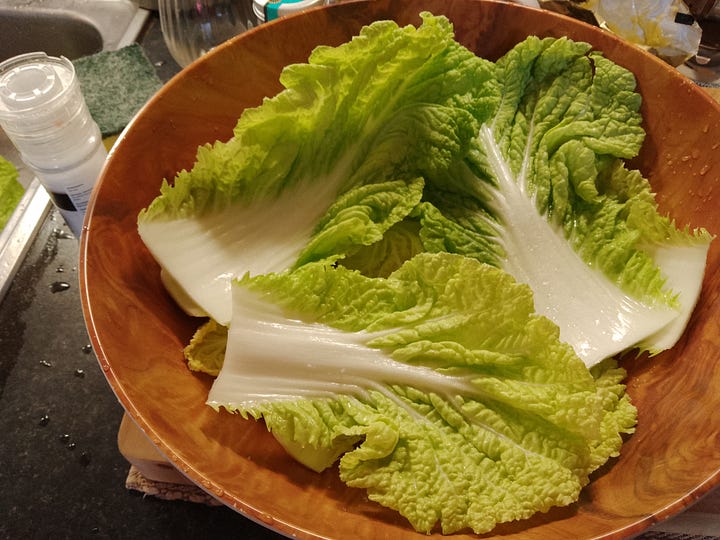
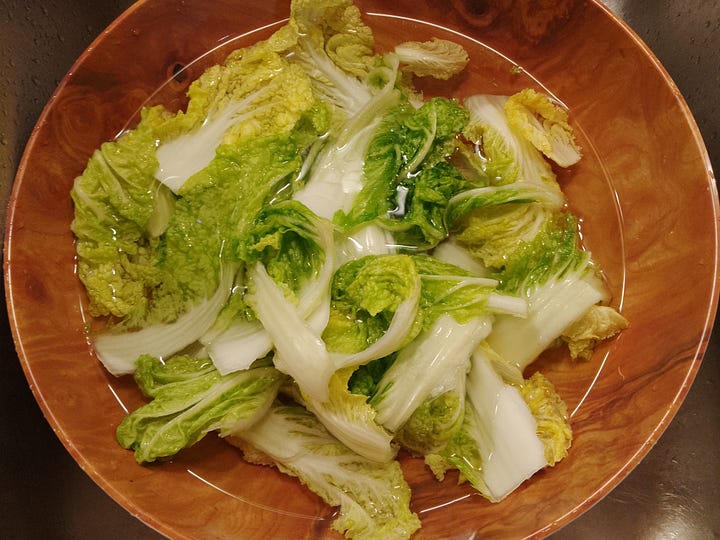
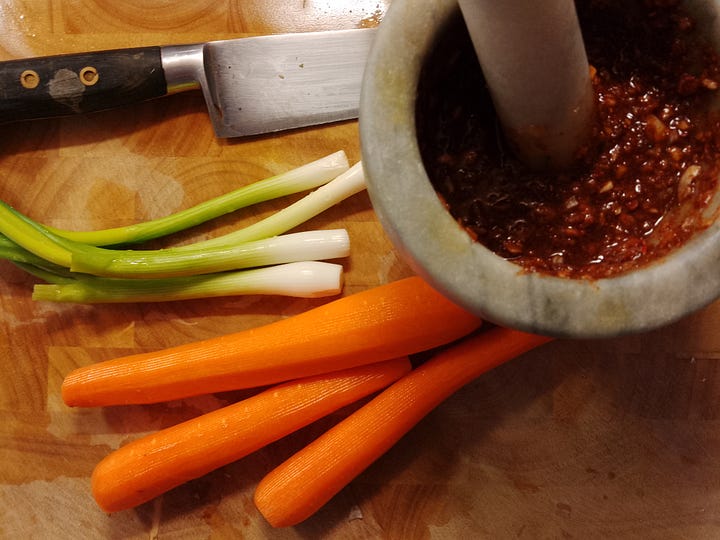
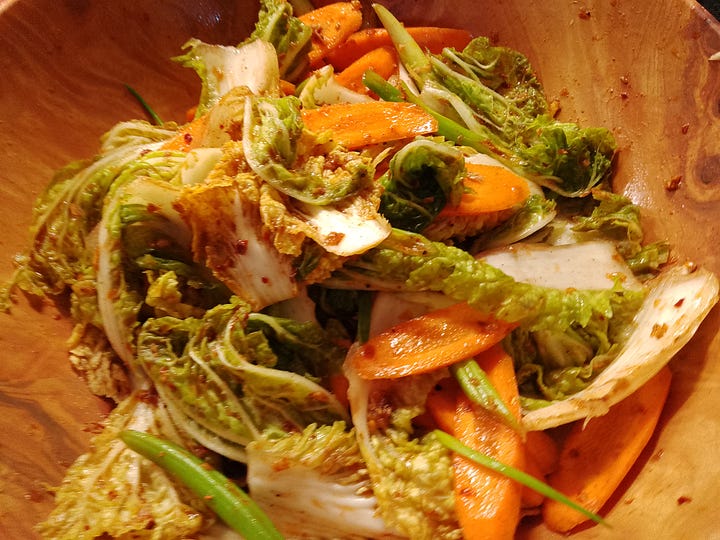
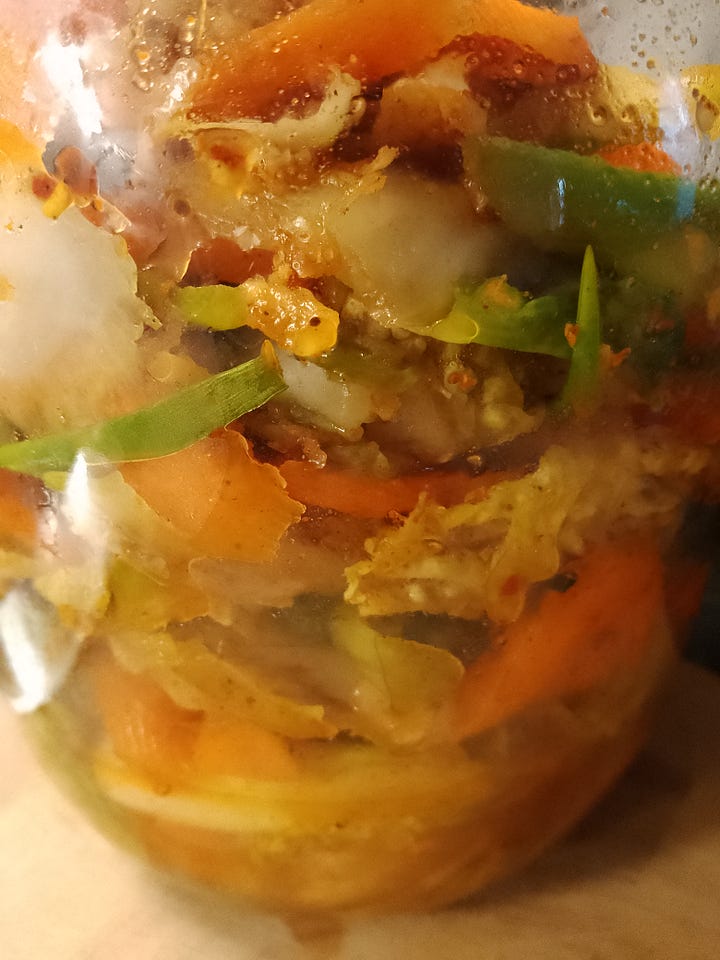
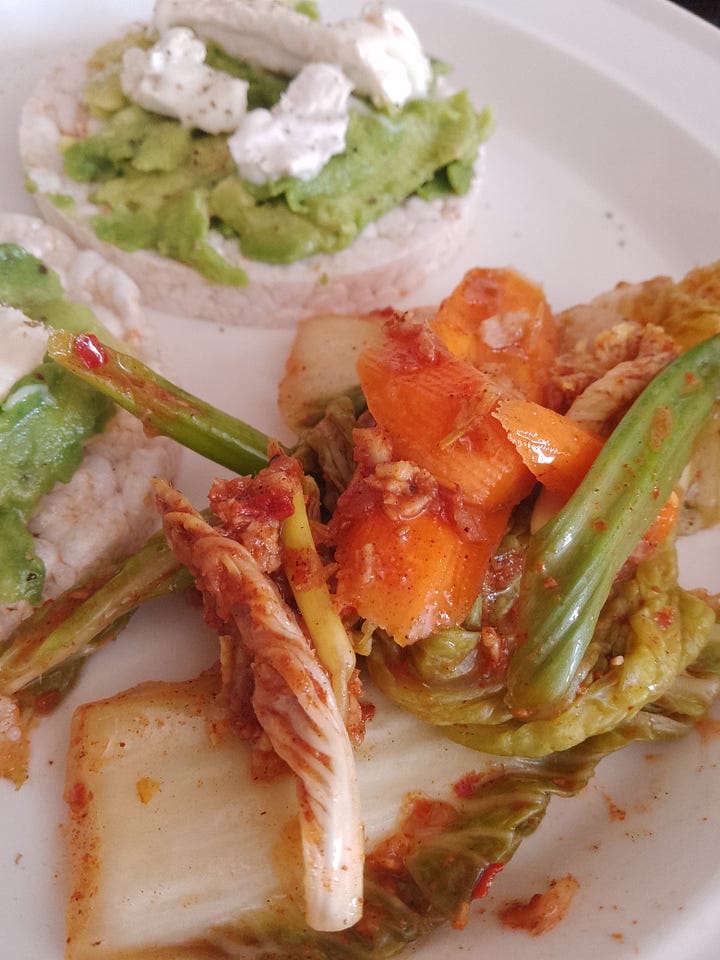
Below: A selection of ferments I have going on at the moment. I try to have a large jar of sauerkraut or cabbage with other veg on-going in the fridge, as well as jars of assorted vegetables such as broccoli, cauliflower, okra, or some ginger bug to make summer drinks. Kefir is a daily product I put on my muesli every morning made with half goat’s milk and half water. It ferments just enough in 24 hours to make a yummy healthy drink. When I make coconut yogurt, I let it ferment for longer and don’t add water.
Let me know if you’d like a post on any of these ferments.
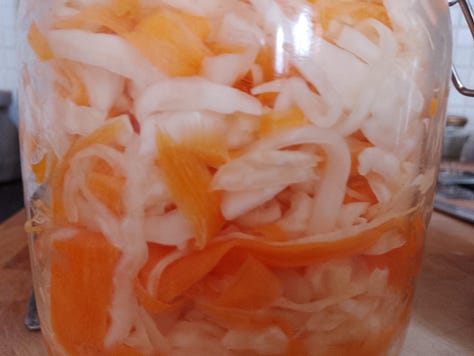
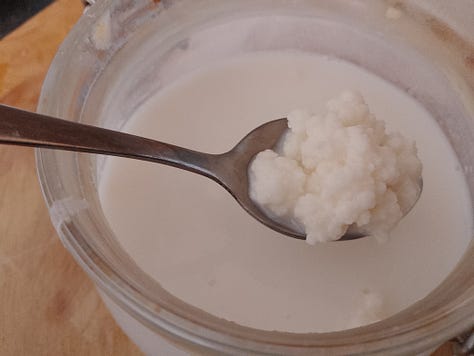
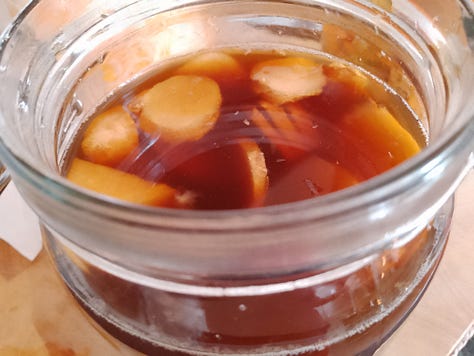
So, have we lost the plot when it comes to a consumer society trapped in an ever-ending cycle of processed foods and deteriorating health? Definitely. But I think there’s hope on the horizon. We need to do our bit by choosing to not be part of the problem and help keep the health movement moving.
Let me know in the comments what ferments you enjoy or if you have a favourite food preservation method.
If you’ve read this far, congratulations. I assume it means you’re interested in knowing how the allotment’s going.
Slowly. Thank you for asking. I have managed to salvage enough old pieces of wood to batten down the cardboard which will stop the grass and weeds growing. The wood will (hopefully) stop the cardboard from flying away. Next step is to find a way to transport several bags of compost to the plot to lay over the cardboard.
Will keep you posted. 😉







Your kimchi recipe is similar to mine but I tend to choose it more like sauerkraut and I don’t do the paste, just mix all those ingredients in. And I’ve never added sugar. So same same but different. I love fermenting and while I don’t have anything actively on the go at the moment, I have a mixed veg pickle and choko kraut in the fridge. Oh yes I do, I have miso getting close to being ready. I ferment milk often - cheese and clabber. And I have recently done a dry aged salami which is also a fermented product. It can be quite magical seeming sometimes! And, I am so with you on our broken food culture but I despair that we can do so little to influence society. I can’t even influence my own family!!
Oh a post script re. the lack of enterprise by the governments, of course it's the money earned by them from food companies that influence their tardiness!!!